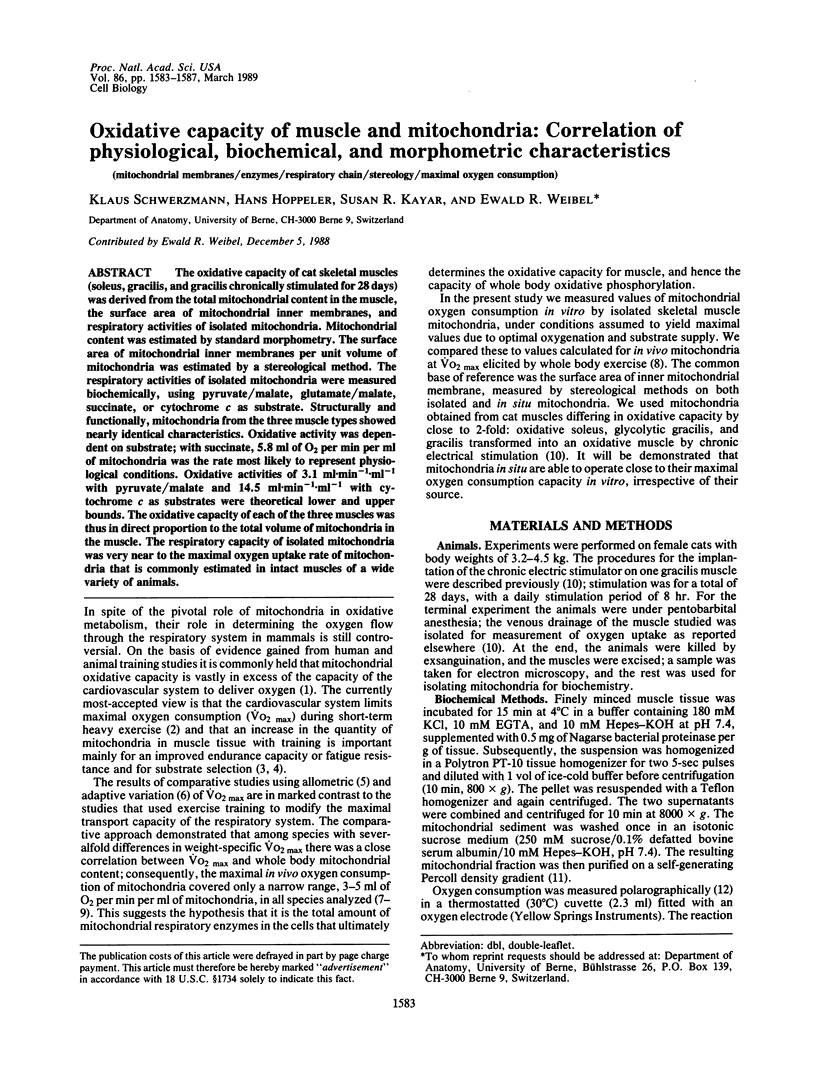Abstract
The oxidative capacity of cat skeletal muscles (soleus, gracilis, and gracilis chronically stimulated for 28 days) was derived from the total mitochondrial content in the muscle, the surface area of mitochondrial inner membranes, and respiratory activities of isolated mitochondria. Mitochondrial content was estimated by standard morphometry. The surface area of mitochondrial inner membranes per unit volume of mitochondria was estimated by a stereological method. The respiratory activities of isolated mitochondria were measured biochemically, using pyruvate/malate, glutamate/malate, succinate, or cytochrome c as substrate. Structurally and functionally, mitochondria from the three muscle types showed nearly identical characteristics. Oxidative activity was dependent on substrate; with succinate, 5.8 ml of O2 per min per ml of mitochondria was the rate most likely to represent physiological conditions. Oxidative activities of 3.1 ml.min-1.ml-1 with pyruvate/malate and 14.5 ml.min-1.ml-1 with cytochrome c as substrates were theoretical lower and upper bounds. The oxidative capacity of each of the three muscles was thus in direct proportion to the total volume of mitochondria in the muscle. The respiratory capacity of isolated mitochondria was very near to the maximal oxygen uptake rate of mitochondria that is commonly estimated in intact muscles of a wide variety of animals.
Full text
PDF




Images in this article
Selected References
These references are in PubMed. This may not be the complete list of references from this article.
- Blomqvist C. G., Saltin B. Cardiovascular adaptations to physical training. Annu Rev Physiol. 1983;45:169–189. doi: 10.1146/annurev.ph.45.030183.001125. [DOI] [PubMed] [Google Scholar]
- Bolender R. P., Paumgartner D., Losa G., Muellener D., Weibel E. R. Intergrated stereological and biochemical studies of hepatocytic membranes. I. Membrane recoveries in subcellular fractions. J Cell Biol. 1978 May;77(2):565–583. doi: 10.1083/jcb.77.2.565. [DOI] [PMC free article] [PubMed] [Google Scholar]
- Chappell J. B. The effects of 2,4-dinitrophenol on mitochondrial oxidations. Biochem J. 1964 Feb;90(2):237–248. doi: 10.1042/bj0900237. [DOI] [PMC free article] [PubMed] [Google Scholar]
- Davies K. J., Packer L., Brooks G. A. Biochemical adaptation of mitochondria, muscle, and whole-animal respiration to endurance training. Arch Biochem Biophys. 1981 Jul;209(2):539–554. doi: 10.1016/0003-9861(81)90312-x. [DOI] [PubMed] [Google Scholar]
- Gollnick P. D. Free fatty acid turnover and the availability of substrates as a limiting factor in prolonged exercise. Ann N Y Acad Sci. 1977;301:64–71. doi: 10.1111/j.1749-6632.1977.tb38186.x. [DOI] [PubMed] [Google Scholar]
- Hoppeler H., Hudlicka O., Uhlmann E. Relationship between mitochondria and oxygen consumption in isolated cat muscles. J Physiol. 1987 Apr;385:661–675. doi: 10.1113/jphysiol.1987.sp016513. [DOI] [PMC free article] [PubMed] [Google Scholar]
- Hoppeler H., Lindstedt S. L. Malleability of skeletal muscle in overcoming limitations: structural elements. J Exp Biol. 1985 Mar;115:355–364. doi: 10.1242/jeb.115.1.355. [DOI] [PubMed] [Google Scholar]
- Kayar S. R., Hoppeler H., Lindstedt S. L., Claassen H., Jones J. H., Essen-Gustavsson B., Taylor C. R. Total muscle mitochondrial volume in relation to aerobic capacity of horses and steers. Pflugers Arch. 1989 Feb;413(4):343–347. doi: 10.1007/BF00584481. [DOI] [PubMed] [Google Scholar]
- Mickelson J. R., Greaser M. L., Marsh B. B. Purification of skeletal-muscle mitochondria by density-gradient centrifugation with Percoll. Anal Biochem. 1980 Dec;109(2):255–260. doi: 10.1016/0003-2697(80)90645-4. [DOI] [PubMed] [Google Scholar]
- Palmer J. W., Tandler B., Hoppel C. L. Biochemical properties of subsarcolemmal and interfibrillar mitochondria isolated from rat cardiac muscle. J Biol Chem. 1977 Dec 10;252(23):8731–8739. [PubMed] [Google Scholar]
- Paumgartner D., Losa G., Weibel E. R. Resolution effect on the stereological estimation of surface and volume and its interpretation in terms of fractal dimensions. J Microsc. 1981 Jan;121(Pt 1):51–63. doi: 10.1111/j.1365-2818.1981.tb01198.x. [DOI] [PubMed] [Google Scholar]
- Pedersen P. L., Greenawalt J. W., Reynafarje B., Hullihen J., Decker G. L., Soper J. W., Bustamente E. Preparation and characterization of mitochondria and submitochondrial particles of rat liver and liver-derived tissues. Methods Cell Biol. 1978;20:411–481. doi: 10.1016/s0091-679x(08)62030-0. [DOI] [PubMed] [Google Scholar]
- Schnaitman C., Greenawalt J. W. Enzymatic properties of the inner and outer membranes of rat liver mitochondria. J Cell Biol. 1968 Jul;38(1):158–175. doi: 10.1083/jcb.38.1.158. [DOI] [PMC free article] [PubMed] [Google Scholar]
- Schwerzmann K., Cruz-Orive L. M., Eggman R., Sänger A., Weibel E. R. Molecular architecture of the inner membrane of mitochondria from rat liver: a combined biochemical and stereological study. J Cell Biol. 1986 Jan;102(1):97–103. doi: 10.1083/jcb.102.1.97. [DOI] [PMC free article] [PubMed] [Google Scholar]
- Tager J. M., Wanders R. J., Groen A. K., Kunz W., Bohnensack R., Küster U., Letko G., Böhme G., Duszynski J., Wojtczak L. Control of mitochondrial respiration. FEBS Lett. 1983 Jan 10;151(1):1–9. doi: 10.1016/0014-5793(83)80330-5. [DOI] [PubMed] [Google Scholar]
- Taylor C. R., Karas R. H., Weibel E. R., Hoppeler H. Adaptive variation in the mammalian respiratory system in relation to energetic demand. Respir Physiol. 1987 Jul;69(1):1–127. doi: 10.1016/0034-5687(87)90097-1. [DOI] [PubMed] [Google Scholar]
- Weibel E. R., Taylor C. R., Gehr P., Hoppeler H., Mathieu O., Maloiy G. M. Design of the mammalian respiratory system. IX. Functional and structural limits for oxygen flow. Respir Physiol. 1981 Apr;44(1):151–164. doi: 10.1016/0034-5687(81)90081-5. [DOI] [PubMed] [Google Scholar]



